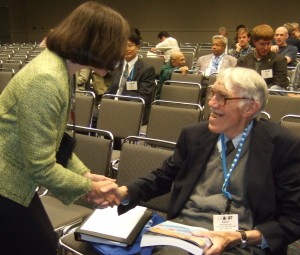Robert Newnham, 80, of State College, Pennsylvania, a resident of Foxdale Village, died at Penn State Hershey Medical Center on April 16, 2009. He was born March 28, 1929, in Amsterdam, New York, the son of the late William E. and Dorothy M. Hamm Newnham.
On July 26, 1964, Newnham married Patricia Friss Newnham, a beautiful nurse from E. Hartford, Connecticut, who survives. The two had two children: a son, Randall E. Newnham of Reading, Pennsylvania, and a daughter, Rosemary E. Newnham of New York City. They survive, along with Randall’s wife Janet Graden, and a grandson – Johnathan Robert Newnham, and Rosemary’s husband Patrick Ying. His sister Mary Lucy Carlson, her husband Rupert, numerous nieces and nephews and their families also survive.
A graduate of four universities, Newnham studied mathematics at Hartwick College (B.S., 1950), physics at Colorado State University (M.S., 1952), physics and mineralogy at Penn State (Ph.D., 1956) and crystallography at Cambridge University (Ph.D., 1960). Prior to joining the Penn State faculty in 1966, he was an I.C.I. Fellow at the Cavendish Laboratory of Cambridge University and taught in the Electrical Engineering Department of M.I.T. for 10 years.
At Penn State, Newnham taught courses on Crystal Physics, Crystal Chemistry, Electroceramics, Mineralogy, Gem Minerals, Biomaterials, X-ray Diffraction, and Crystal Structure Analysis. Widely known for his enthusiastic lectures and colorful illustrations, Newnham was honored with the Outstanding Educator Award of the Ceramic Education Council, and the Wilson Teaching Prize of the College of Earth and Mineral Sciences. During his career, he delivered the Dow Lectures at Northwestern University, the Wolff Lecture at M.I.T., the McMahon Lecture at Alfred University, the Pond Lectures at Johns Hopkins, the Maddin Lecture at the University of Pennsylvania, and the Byron Short Lecture at the University of Texas. After retirement, Newnham taught for two years at the Hong Kong Polytechnic University and the Georgia Institute of Technology.
Newnham was active in several professional societies serving as Editor of the Journal of the American Ceramic Society, secretary of the Materials Research Society, president of the American Crystallographic Association, and Distinguished Lecturer for the Institute of Electrical and Electronic Engineers. Among his many awards was the Jeppson Medal, the E.C. Henry Award, the Bleininger Award, the David Kingery Award of the American Ceramic Society, the third Millennium Medal and Ultrasonics Achievement Award of the IEEE, the Centennial Award of the Japan Ceramics Society, the Turnbull Lecturer Award of the Materials Research Society, the Adaptive Structures Prize of the American Society of Mechanical Engineers, the Benjamin Franklin Medal for Electrical Engineering from the Franklin Institute, and the Basic Research Award of the World Academy of Ceramics.
A member of the National Academy of Engineering, Newnham wrote five books, more that 500 research papers and 20 patents on electroceramics and composite materials for electronic and acoustic applications. The composite piezoelectric transducers developed in his laboratory revolutionized the quality of ultrasound images in cardiology, obstetrics, and underwater sonar. Every major ultrasonics manufacturer in the world including several in central Pennsylvania use composite transducers based on his designs. His miniature flextensional transducers for hydrophone towed arrays is one Penn State’s most successful patents. They are widely used in underwater oil explorations and geophysical research.
During the past forty years, Newnham and his long-time colleague Eric Cross, built up one of the largest ferroelectrics research programs in the world. Together, they pioneered a number of new piezoelectric and electrostrictive materials for use as sensors, actuators, and capacitors. They were the first to carry out a complete classification of primary and secondary ferroics with examples of each.
He retired from Penn State in 1999 as Alcoa Professor Emeritus after serving eight years as associate director of the Materials Research Laboratory and 18 years as director of the Intercollege Program on Solid State Science. Newnham is remembered with great love by friends, former students and scientific colleagues around the globe.
In private life, Newnham was an unabashed liberal in politics and religion. He and his wife, Pat, were strong supporters of the peace movement, the Unitarian-Universalist Fellowship of Centre County, and numerous liberal charities. In his spare time, he was an ardent mineral collector and model airplane builder, and loved the smell of airplane glue.

